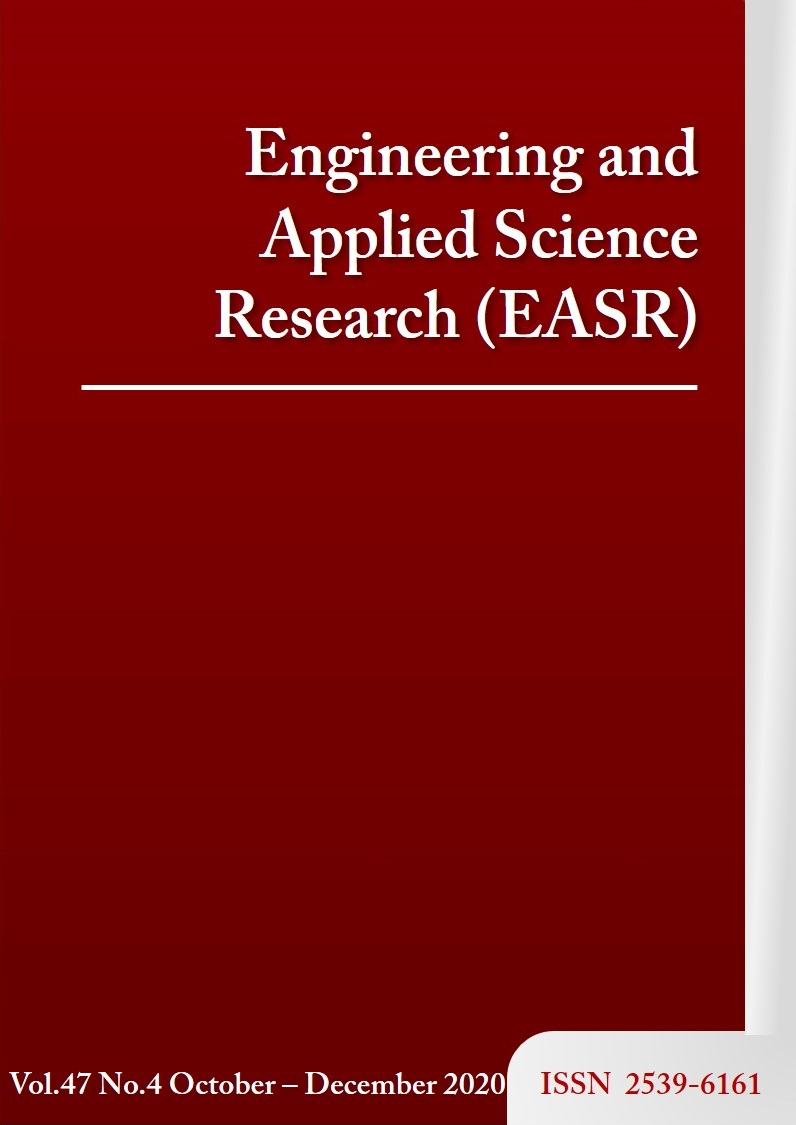Tamanu and coconut oil blends for soap making from extraction of Tamanu kernel with coconut milk
Main Article Content
Abstract
This is a study on the extraction of oil from raw tamanu (Calophyllum inophyllum L.) kernel with milk from fresh coconut (Cocos nucifera L.) to obtain a blend (TCO) of these. The weight ratios of raw tamanu kernel (RTK) and grated coconut meat (GCM) were varied and fatty acid compositions were assessed. The RTK/GCM ratios were 0.15, 0.25 or 0.35 in 1.0 kg batches of RTK and GCM heated to 70 °C in a water bath. The yield of mixed oil was 14.7, 16.1 and 18.0 for the RTK/GCM ratios of 0.15, 0.25 and 0.35, whereas the yields of pure tamanu oil (TO) and pure coconut oil (CO) were 31.6 and 18.3, respectively. The ratios of unsaturated fatty acids (UFA) to saturated fatty acids (SFA) were 30:70, 40:60 and 51:49 for the respective RTK/GCM ratios 0.15, 0.25 and 0.35. Saponification number, iodine value, and acid value were determined for the extracts. The results indicate the RTK to GCM ratio 0.25 as advantageous, giving an appropriate UFA:SFA ratio of 40:60. Soaps made from CO were assessed and a target TCO was investigated. The soap properties tested satisfied the Thai Community Product Standard of soap (TCPS 94-2546) and the Thai Industrial Standard TIS 29-2545. The TCO soap had better properties than the CO soap as regards pH, hardness, moisture content, and total fatty matter.
Article Details
This work is licensed under a Creative Commons Attribution-NonCommercial-NoDerivatives 4.0 International License.
References
Intahphuak S, Khonsung P, Panthong A. Anti-inflammatory, analgesic, and antipyretic activities of virgin coconut oil. Pharmaceut Biol. 2010;48(2):151-7.
Benjamin SE, Abbass A. Effect of superfatting agents on soaps properties. J Oil Palm Res. 2019;31(2):304-14.
Lin TK, Zhong L, Santiago JL. Anti-inflammatory and skin barrier repair effects of topical application of some plant oils. Int J Mol Sci. 2017;19(1):1-21.
GEO-Informatics Research Center for Natural Resource and Environment, Southern Regional Center of Geo-Informatics and Space Technology. Area of Hua Sai district, Nakhon Si Thammarat province, Thailand. Songkhla, Thailand: Prince of Songkla University; 2019.
Nadeeshani R, Wijayaratna UN, Prasadani WC, Ekanayake S, Seneviratne KN, Jayathilaka N. Comparison of the basic nutritional characteristics of the first extract and second extract of coconut milk. Int J Innovat Res Sci Eng Tech. 2015;4(10):9516-21.
Widyasanti A, Ginting AML, Asyifani E, Nurjanah S. The production of paper soaps from coconut oil and virgin coconut oil (VCO) with the addition of glycerine as plasticizer. IOP Conf Ser Earth Environ Sci. 2018;141(1):1-13.
Nguyen HH, Tran TTM. Chemical composition analysis and antibacterial-antiinflammatoryactivity tests of tamanu seed oil extracted by supercritcial fluid technology. Sci Tech Dev. 2016;19(3):146-54.
AOAC. Official method 920.160 Saponification number of oils and fats. 17th ed. Maryland: AOAC; 2000.
Zauro SA, Abdullahi MT, Aliyu A, Muhammad A, Abubakar I, Sani YM. Production and analysis of soap using locally available raw-materials. Elixir Appl Chem. 2016;96:41479-83.
Kumar GVP, Lakshmi NVVSS, Deena C, Sekhar VC, Nikhitha NM, Begum MMH, et al. Determination of the quality of coconut oils (unrefined grade) and (refined grade) produced from three survey regions of East Godavari district, India. Asian J Appl Chem Res. 2018;2(3-4):1-8.
Botinestean C, Hadaruga NG, Hadaruga DI, Jianu I. Fatty acids composition by gas chromatography-mass spectrometry (GC-MS) and most important physical-chemicals parameters of tomato seed oil. J Agroaliment Process Tech. 2012;18(1):89-94.
Warra AA, Hassan LG, Gunu SY, Jega SA. Cold-process synthesis and properties of soaps prepared from different triacylglycerol sources. Nig J Basic Appl Sci. 2010;18(2):315-21.
Wongsathan MT. Improvement of saponification process and properties of waste in production of carotenoids from crude palm oil [dissertation]. Chiang Mai: Chiang Mai University; 2008.
Vivian OP, Nathan O, Osano A, Mesopirr L, Omwoyo WN. Assessment of the physicochemical properties of selected commercial soaps manufactured and sold in Kenya. J Appl Sci. 2014;4(8):433-40.
Afsar Z, Khanam S. Formulation and evaluation of poly herbal soap and hand sanitizer. Int Res J Pharm. 2016;7(8):54-7.
Boadu KO, Anang MA, Kyei SK. Chemical characterization of shea butter oil soap (Butyrospermum parkii G. Don ). Int J Dev Sustain. 2017;6(10):1282-92.
Phanstiel O, Dueno E, Wang QX. Synthesis of exotic soaps in the chemistry laboratory. J Chem Educ. 2009;75(5):612-4.
Ogunsuyi HO, Akinnawo CA. Quality assessment of soaps produced from palm bunch ash-derived alkali and coconut oil. J Appl Sci Environ Manag. 2012;16(4):363-6.
Popescu V, Soceanu A, Dobrinas S, Stanciu G, Epure DT. Quality control and evaluation of certain properties for soaps made in Romania. Sci Stud Res: Chem Chem Eng Biotechnol Food Ind. 2011;12(3):257-61.
Oluwatoyin SM. Quality of soaps using different oil blends. J Microbiol Biotechnol Res. 2011;1(1):29-34.



